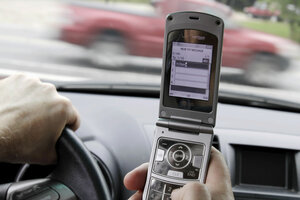Most teens are texting and driving; parents silent
Texting and driving is still the norm among teen drivers, a new study finds. But parents are not talking about it.

Texting and driving remains the norm among teen drivers, a new study shows. But parents aren't talking about it.
Pat Wellenbach/AP
Texting and driving is still the norm among teen drivers, a new survey says, and few parents are talking about it.
Only 22 percent of parents talk regularly about safe driving with their teenage children who have driver's licenses, the study found, while most young drivers continued to view texting and driving as less dangerous than drunk driving.
And despite years now of high-profile campaigns against distracted driving, 57 percent of teens with driver's licenses admit to texting while driving, according to the report commissioned by State Farm insurance. While 83 percent of these teens agree that they will get into an accident if they regularly drink and drive (which makes you wonder, really, what’s up with the other 17 percent), only 63 percent feel the same about texting behind the wheel.
Yikes.
It’s worth recapping here: When people text, it’s as if they are closing their eyes behind the wheel – often for the length of football fields, depending on how fast one’s driving.
The dangers surrounding texting while driving are so intense because there are multiple sorts of distractions wrapped up into one act – physical (the actual texting takes hands off the wheel), visual (the driver takes his or her eyes off the road), and cognitive (the driver’s mind focuses on something other than the road).
And while lots of people think they can multiprocess – they’re the ones, of course, who can text and drive without danger – research shows the vast majority of people far overestimate their abilities.
At the University of Utah’s Applied Cognition Laboratory, for instance, David Strayer and other professors used neuroimaging and a drive simulator to observe people who claim to be able to text, tweet, or talk at the wheel safely. For 98 percent of the population, the likelihood of a crash while on the cellphone increases fourfold. And that number goes up exponentially when you look at texting and teen drivers.
If that’s not scary enough, study after study add to the details. (Although some critics do wonder why, if this is all so dangerous, we haven’t seen even more deaths on the road.) In 2010 the National Safety Council estimated that at least 200,000 crashes a year are caused by texting and driving. Teens are more likely than any other age group to be involved in a fatal crash where distraction is reported, according to the National Highway Transportation Safety Association. And 40 percent of all American teens say they have been in a car when the driver used a cell phone in a way that put people in danger, according to the Pew Research Center.
None of this information, though, seems to have impacted behavior among teens. Neither have a slew of new state laws against texting and driving. The State Farm survey shows almost the exact same results as a similar survey taken two years ago.
But the silver lining for moms and dads:
What does seem to work, the survey discovered, was parent intervention.
Teens who do not text and drive were more likely to report having frequent talks with their parents about safe driving – 82 percent compared with 67 percent who do text and drive.
The survey showed that teens and parents tend to talk less about safe driving after the teen actually gets his or her license – just the time when those conversations should increase.
So start talking.

